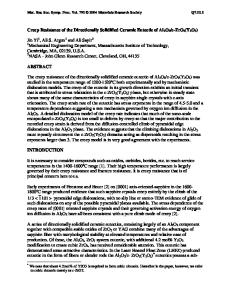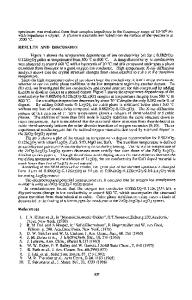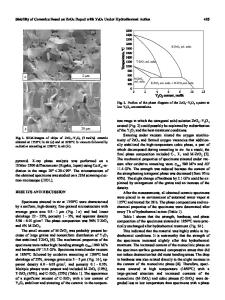Deposition and mechanical properties of polycrystalline Y 2 O 3 /ZrO 2 superlattices
- PDF / 805,224 Bytes
- 9 Pages / 612 x 792 pts (letter) Page_size
- 14 Downloads / 422 Views
MATERIALS RESEARCH
Welcome
Comments
Help
Deposition and mechanical properties of polycrystalline Y2O3/ZrO2 superlattices Philip C. Yashara) and Scott A. Barnett Department of Materials Science and Engineering, Northwestern University, Evanston, Illinois 60208
Lars Hultman Thin Film Physics Division, Department of Physics, Linko¨ping University, S-581 83 Linko¨ping, Sweden
William D. Sproulb) Advanced Coatings Technology Group, Northwestern University, Evanston, Illinois 60201 (Received 3 February 1999; accepted 13 June 1999)
Polycrystalline Y2O3/ZrO2 superlattice thin films were deposited using opposedcathode reactive magnetron sputtering. Pulsed direct-current power was used to eliminate arcing on the metallic targets. Radio-frequency power was applied to the substrates to achieve ion bombardment of the growing film. In order to reproducibly deposit at high rates in Ar–O2 mixtures, the Y target voltage was used to indirectly feedback-control the O2 partial pressure. Deposition rates as high as ∼70% of the pure metal rates were achieved, typically 3.5 m/h. Superlattices with periods ranging from 2.6 to 95 nm were deposited. Y2O3 layer thicknesses were either 75% or 50% of the superlattice period. X-ray diffraction and transmission electron microscopy studies showed well-defined superlattice layers. The ZrO2 layers exhibited the hightemperature cubic-fluorite structure, which was epitaxially stabilized by the cubic Y2O3 layers, for thicknesses 艋7 nm. The equilibrium monoclinic structure was observed for thicker ZrO2 layers. Nanoindentation hardnesses ranged from 11.1 to 14.5 GPa with little dependence on period. The hardness results are discussed in terms of current superlattice hardening theories.
I. INTRODUCTION
Nitride superlattices with nanometer-thick layers, e.g., TiN/VN1 and TiN/NbN,2,3 as well as metallic superlattices, e.g., Cu/Ni,4 have shown large increases in hardness and/or strength over rule of mixtures values. Models accounting for the effect of interfaces on dislocation motion provide reasonably good agreement with the hardness enhancement data.5,6 It is not known whether oxide superlattices would exhibit similar hardness increases. The combination of increased hardness with the desirable properties of oxide coatings—including optical transparency, excellent corrosion resistance, stability in oxidizing atmospheres, and high-temperature stability—would be of considerable technological interest. Superlattice hardness enhancements would be expected if the same dislocation mechanisms that provide hardness en-
a)
Present address: Materials Science and Technology Division, Los Alamos National Laboratory, Los Alamos, NM 87545. b) Present address: Reactive Sputtering, Inc., 4555 Via Clarice, Santa Barbara, CA 93111. 3614
http://journals.cambridge.org
J. Mater. Res., Vol. 14, No. 9, Sep 1999 Downloaded: 14 Mar 2015
hancements in nitride and metallic superlattices are important. While dislocation plasticity has been observed at indentations in oxide materials, e.g., Al2O3,7 it is also well-known
Data Loading...











